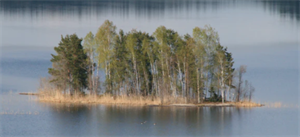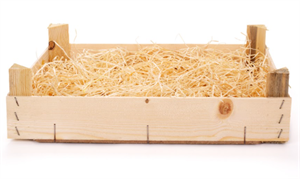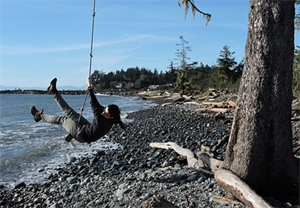PDF chapter test TRY NOW
Once home, a squad of coolies were engaged for special work in our compound. An island was made for Baba. It was twenty feet long and fifteen feet wide, and was surrounded by a dry pit, or moat, six feet wide and seven feet deep. A wooden box that once housed fowls was brought and put on the island for Baba to sleep in at night. Straw was placed inside to keep him warm, and his ‘baby’, the gnarled stump, along with his ‘gun’, the piece of bamboo, both of which had been sentimentally preserved since he had been sent away to the zoo, were put back for him to play with.
In a few days the coolies hoisted the cage on to the island and Baba was released. He was delighted; standing on his hindlegs, he pointed his ‘gun’ and cradled his ‘baby’. My wife spent hours sitting on a chair there while he sat on her lap. He was fifteen months old and pretty heavy too!
The way my wife reaches the island and leaves it is interesting. I have tied a rope to the overhanging branch of a mango tree with a loop at its end. Putting one foot in the loop, she kicks off with the other, to bridge the six-foot gap that constitutes the width of the surrounding pit. The return journey is made the same way. But who can say now that a sloth bear has no sense of affection, no memory and no individual characteristics?
Explanation:
The narrator and his wife finally convince the superintendent to give them the bear back, and he is brought home in a lorry. Things were getting ready for him to stay comfortably. The reason for sending him to the zoo was that he had grown in size and might pose as a threat to the neighbourhood. This time, they take special care for this not to be a hindrance for him staying with them. A group of workers were called and made to engage in making a special island for the bear. The island was spacious enough for him. It was twenty feet long, fifteen feet wide (Around six meters). To make it look more like an island, they made a dry pit filled with water which was only six feet wide and seven feet deep, so that it was not dangerous for the bear. It also acted as a small boundary between the human and the animal habitat.

Land surrounded by water
A wooden box served as his home in the island. It was once used as a shelter for the narrator's chickens and hens. It made him a warm shelter to sleep at night. They also add his old toys and favourite things, thereby making it nostalgic for the bear. Straw was placed inside the wooden box to make a warm bed for him. It is common for people to cherish material things of people whom they love when they are not around, since it contains a part of them. Similarly, the narrator's wife had missed the bear so much that she has securely preserved the bear's stick gun and wooden stump, which he considered as his 'baby'. They were put back in his new home to make him feel welcome.

Wooden box with straw
The bear finally arrives in the island. Few workers from the zoo, bring him in a cage although it was unnecessary to have a cage for such a tamed bear. But when he reaches his home, he is so happy and understands that he no longer has to be lonely at the zoo and stands in his hind leg and plays with his gun. He points the stick gun at people exactly how he had done before leaving the house. He even cradles the wooden stump as his baby, showing that in spite of being away from home for months together, he had not forgotten a single thing and had treasured his memories. On contrary to the popular belief that animals do not have feelings or memory, he exerts great love towards his former owners. The narrator's wife is relieved that he is back and still considers him as her own baby. She sits beside him in the island in a chair and sometimes makes him sit on her lap in spite of him being very heavy. He was fifteen months old and was way beyond the stage of sitting in a human's lap. But love can oversee pain and discomfort and the narrator's wife plays the role of a mother who cannot have enough of getting her son back.

Happy bear standing on hind legs
She enters the island in an interesting way. Since the distance between the island and the home is only six feet, which is short, the narrator ties a rope to a mango tree within the premises and makes a loop at the end of it. She holds onto the rope, puts one foot on the loop and gives a push with her other foot, so it takes her to the island. It is easy for her to visit her beloved, which takes only a moment. The narrator concludes from the story that even wild animals can be affectionate when brought in a suitable condition. He can learn to reciprocate the love showered to him. The bear does not forget anything or anyone from his old home when he goes to the zoo. He keeps them in his memories and cherishes them as his best, hence proving that an animal can be as loving and caring as a human can be. The bear is capable of individual choices and characteristics like love, which makes him unique.

Woman swinging on a rope
Meaning of difficult words:
| SI.no | Words | Meaning |
1 | Squad | A group of people doing a common job |
2 | Coolies | A worker who is mostly paid on a daily basis |
3 | Island | A land surrounded by water on four sides |
4 | Moat | A deep pit filled with water |
5 | Gnarled | Knotted and rough |
6 | Fowls | Birds |
7 | Hoist | To lift |
8 | Hind leg | The two legs in front of the animal |
9 | Loop | A rope that is doubled over |
10 | Constitute | The cause to stand |
11 | Hindrance | Something that holds back |
12 | Nostalgic | Reminding of one's earlier days |
Reference:
National Council of Educational Research and Training (2006). Beehive. The Bond of Love - Kenneth Anderson (pp.113-118). Published at the Publication Division by the Secretary, National Council of Educational Research and Training, Sri Aurobindo Marg, New Delhi.
